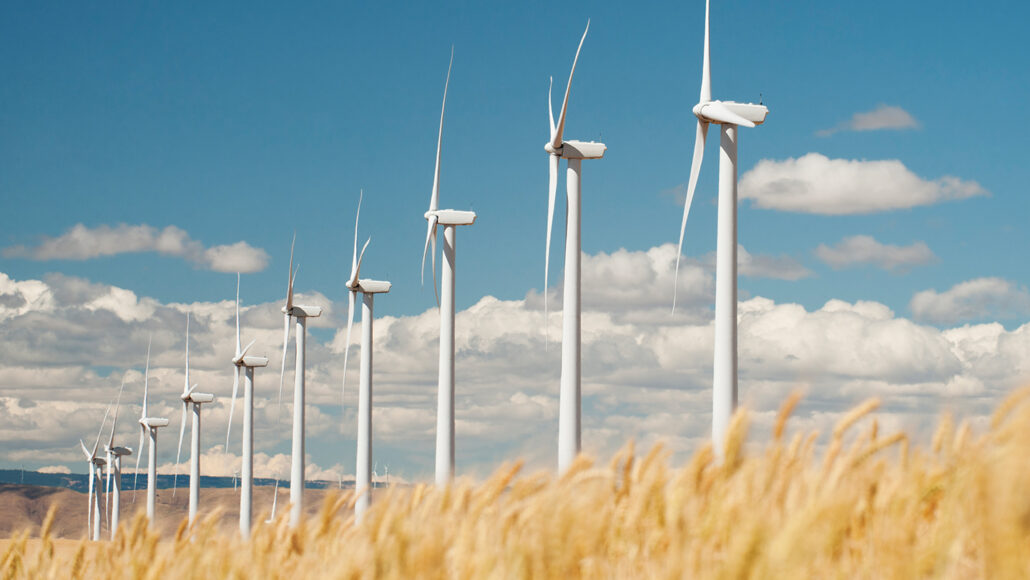Questions for ‘The world is aiming for ‘net zero’ greenhouse gas emissions’

Curbing climate change means getting more electricity from renewable sources. Turbines such as these harness the power of wind to generate electricity.
Erik Isakson/ Tetra images/Getty Images
Share this:
- Share via email (Opens in new window) Email
- Click to share on Facebook (Opens in new window) Facebook
- Click to share on X (Opens in new window) X
- Click to share on Pinterest (Opens in new window) Pinterest
- Click to share on Reddit (Opens in new window) Reddit
- Share to Google Classroom (Opens in new window) Google Classroom
- Click to print (Opens in new window) Print
To accompany ‘The world is aiming for ‘net zero’ greenhouse gas emissions’
SCIENCE
Before Reading:
- Imagine a full bathtub with the drain open and the faucet running. You watch this bathtub for quite a while, but the water level does not change. What does that tell you about the amounts of water going into and draining out of the bathtub? A climate scientist might describe this water outflow as “net zero.” Based on the information in this short scenario, what kind of situation do you think “net zero water outflow” describes?
- Describe one animal species that will likely be affected by climate change. Will it be affected positively or negatively? In one or two sentences, describe the impact of climate change on this species. How important do you think it is to address climate change? Briefly explain what brought you to this decision.
During Reading:
- Describe the actions California took to inspire a “community response” that helped the state avoid energy blackouts. How did the community respond to that action?
- By how many degrees Celsius has the Earth warmed since the mid- to late-1800s?
- What does it mean for greenhouse gas emissions to be “net zero”? Would a “decarbonized” society help or hinder the goal of achieving net zero emissions worldwide? List two examples of power sources that emit no greenhouse gases.
- The story says emissions of carbon dioxide — CO2 — are still growing. But what is hopeful or promising about the rate at which those emissions are growing?
- Which greenhouse gas is most important to get under control? Why?
- How does methane compare to CO2 in terms of heat-trapping capabilities?
- What year was the Paris accord drawn up? What did the nations that signed the Paris accord pledge to do?
- What fortunate change over the last decade makes an almost four-fold “scale-up” of wind and solar-powered energy possible?
- Describe the furnace innovation that allows China to produce steel more efficiently.
- What are biofuels made from? Why are they “essentially net zero” in terms of carbon emissions?
- How many underground CO2 storage operations exist worldwide? How many metric tons of CO2 does do they remove from the air each year?
- According to the Princeton team, the United States must invest how much in additional funds over the next 10 years to reach its goal of going net zero by 2050?
After Reading:
- A student argues, “We can never get to net zero because we will always produce some greenhouse gases.” What does this student not understand about the concept of “net zero”? The story states that even if people switch entirely to clean energy, we still must pull CO2 from the air to achieve “net zero” emissions. What are some potential sources of greenhouse gases beyond what comes from burning fossil fuels?
- As a class, list the different ways this story proposes our society could achieve net zero emissions. Discuss to which of these your local city could contribute. Working solo, write a letter to a local official, such as a mayor, arguing for a specific change to be made in your town. Refer to information from this story to support your argument.
- Sometimes, doing the right thing may be easier or cheaper than doing the wrong thing. Come up with one way a student could help reduce climate change and save money or time in the process. (Hint: Think of reusing materials, or using alternate, cheaper energy sources.)